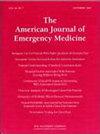Improper performance of HINTS exam in emergency physicians is driven by incorrect use of nystagmus
IF 2.7
3区 医学
Q1 EMERGENCY MEDICINE
引用次数: 0
Abstract
Objective
The HINTS exam is a useful clinical tool for the emergency physician (EP) to differentiate between a central or peripheral cause of dizziness in patients with continuous dizziness and nystagmus and GRACE guidelines strongly recommend that EPs utilize this test. However, previous data show variable results on how well EPs perform the HINTS exam. We aimed to retrospectively assess how accurately EPs select patients for (and thus correctly perform) the HINTS exam.
Methods
A retrospective study was conducted using one full year of patient charts from the emergency department of a public hospital with an emergency residency program. Charts were pulled from the EMR if they contained the words: “hints,” “skew,” or “impulse.” Charts were then manually reviewed and irrelevant charts were excluded. Remaining charts were analyzed for documentation and interpretation of the HINTS exam and categorized as “appropriate” vs “inappropriate” vs. “either way”. “Inappropriate” charts were analyzed further for presence of nystagmus and dizziness.
Results
A total of 175 patient encounters were reviewed in this study, of which 29 cases were inapplicable. Of the remaining 146 cases, 71.2 % (95 % CI 63.5–78.1 %) of HINTS exams were performed on inappropriate patients. The majority of these was due to the exam's being performed on patients without nystagmus.
Conclusions
Based on our findings, EPs utilize the HINTS exam inappropriately the vast majority of the time. Much of this is due to their performing the HINTS exam on patients without nystagmus.
急诊科医师的提示检查表现不佳是由于误用眼球震颤所致
目的提示检查是急诊医师鉴别持续性头晕和眼球震颤患者中枢性或外周性头晕原因的有用临床工具,GRACE指南强烈建议急诊医师使用该检查。然而,之前的数据显示,ep在hint考试中的表现不尽相同。我们的目的是回顾性评估EPs选择患者进行提示检查的准确性(从而正确执行提示检查)。方法回顾性分析某公立医院急诊住院医师项目一整年的患者病历。如果图表包含“暗示”、“倾斜”或“冲动”等词,就会从电子病历中提取出来。然后手工检查图表,排除不相关的图表。剩下的图表被分析为提示考试的文档和解释,并被分类为“合适”、“不合适”和“任意”。进一步分析“不合适”的图表是否存在眼球震颤和头晕。结果本研究共回顾了175例患者,其中29例不适用。其余146例中,71.2% (95% CI 63.5 - 78.1%)的提示检查是在不合适的患者身上进行的。其中大部分是由于在没有眼球震颤的患者身上进行了检查。结论:根据我们的研究结果,绝大多数情况下,EPs不恰当地使用了提示检查。这在很大程度上是由于他们对没有眼球震颤的患者进行了提示检查。
本文章由计算机程序翻译,如有差异,请以英文原文为准。
求助全文
约1分钟内获得全文
求助全文
来源期刊
CiteScore
6.00
自引率
5.60%
发文量
730
审稿时长
42 days
期刊介绍:
A distinctive blend of practicality and scholarliness makes the American Journal of Emergency Medicine a key source for information on emergency medical care. Covering all activities concerned with emergency medicine, it is the journal to turn to for information to help increase the ability to understand, recognize and treat emergency conditions. Issues contain clinical articles, case reports, review articles, editorials, international notes, book reviews and more.

 求助内容:
求助内容: 应助结果提醒方式:
应助结果提醒方式:


